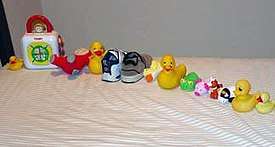Punding
Punding is a term that was coined originally to describe complex prolonged, purposeless, and stereotyped behaviour in phenmetrazine and chronic amphetamine users, by Swedish forensic psychiatrist G. Rylander, in 1968.[1] It was later described in Parkinson's disease.[2] It has also been described in methamphetamine and cocaine users, as well as in some patients with gambling addictions, and hypersexuality.[3]

Punding activity is characterized by compulsive fascination with and performance of repetitive, mechanical tasks, such as assembling and disassembling, collecting, or sorting household objects. For example, punding may consist of activities such as:
- collecting pebbles and lining them up as perfectly as possible,
- disassembling wristwatches and putting them back together again,
- building hundreds of small wooden boxes
- trying but failing to systematically remove the entire contents of all the drawers and shelves in the home and sort through all their contents.
People engaging in punding find immersion in such activities comforting, even when it serves no purpose, and generally find it very frustrating to be diverted from them. They are not generally aware that there is a compulsive element, but will continue even when they have good reason to stop. Rylander describes a burglar who started punding and could not stop, even though he was suffering from an increasing apprehension of being caught.[4]
Interrupting can lead to various responses, including violent rage.[5]
Dopamine overactivity results in punding. It is commonly associated with side effects of drugs used against Parkinson's disease and with the use of methamphetamine. In Parkinson's, punding can be alleviated by lowering the medication dose or adding (atypical) antipsychotics, which act by counteracting the effect of dopamine.
Punding is also similar to behaviors associated with autism.
Punding as a drug-induced behaviour is similar to that observed in obsessive–compulsive disorder. Many disorders can be precipitated by drug use and tend to dissipate following cessation of drug use, although some disorders may affect the consciousness longer, depending on duration and frequency of drug use, as such behaviours can become embedded in the psyche if repeatedly performed.
See also
- Knolling
- Stimming
- Tweaking (behavior)
Notes
- Folke Sjöqvist; Malcolm Tottie, eds. (1969). "Clinical and Medico-criminological aspects of addiction to Central Stimulating Drugs". Abuse of central stimulants: Symposium arranged by the Swedish Committee on International Health Relations, Stockholm, November 25–27, 1968. Almqvist & Wiksell: 257.
- Evans AH; Katzenschlager R; Paviour D; et al. (April 2004). "Punding in Parkinson's disease: its relation to the dopamine dysregulation syndrome". Mov. Disord. 19: 397–405. doi:10.1002/mds.20045. PMID 15077237.
- Graham NA, Hammond CJ, Gold MS (2009). "Drug-induced compulsive behaviors: exceptions to the rule". Mayo Clin. Proc. 84: 846–7, author reply 847. doi:10.1016/S0025-6196(11)60497-7. PMC 2735437. PMID 19720785.
- Lester Grinspoon; Peter Hedblom (1975). The Speed Culture: Amphetamine Use and Abuse in America. Harvard Paperbacks Series. Harvard University Press. p. 104. ISBN 9780674831926.
- Elaine A. Moore (2010). The Amphetamine Debate: The Use of Adderall, Ritalin and Related Drugs for Behavior Modification, Neuroenhancement and Anti-Aging Purposes. McFarland health topics. 10. McFarland. p. 186. ISBN 9780786480128.